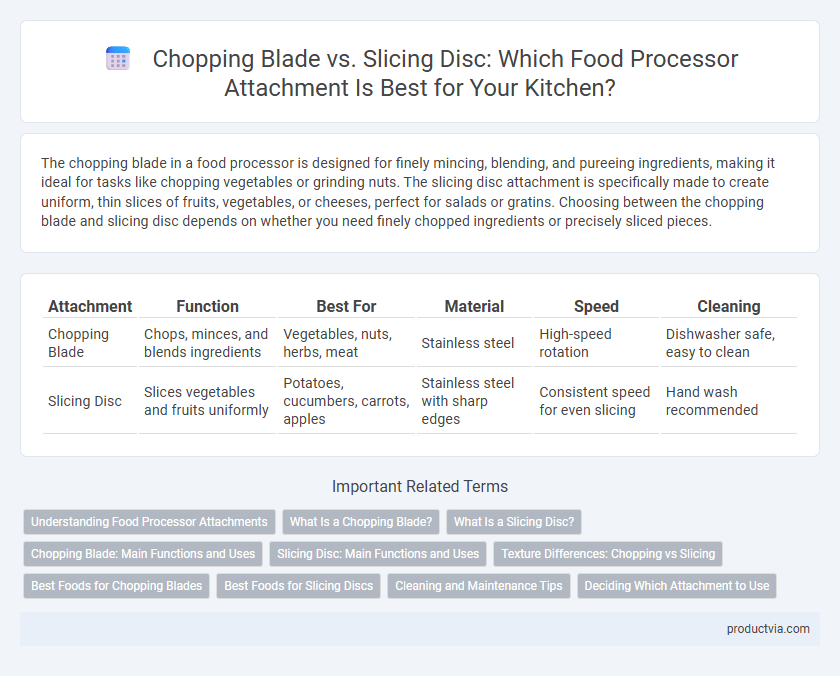The chopping blade in a food processor is designed for finely mincing, blending, and pureeing ingredients, making it ideal for tasks like chopping vegetables or grinding nuts. The slicing disc attachment is specifically made to create uniform, thin slices of fruits, vegetables, or cheeses, perfect for salads or gratins. Choosing between the chopping blade and slicing disc depends on whether you need finely chopped ingredients or precisely sliced pieces.
Table of Comparison
| Attachment | Function | Best For | Material | Speed | Cleaning |
|---|---|---|---|---|---|
| Chopping Blade | Chops, minces, and blends ingredients | Vegetables, nuts, herbs, meat | Stainless steel | High-speed rotation | Dishwasher safe, easy to clean |
| Slicing Disc | Slices vegetables and fruits uniformly | Potatoes, cucumbers, carrots, apples | Stainless steel with sharp edges | Consistent speed for even slicing | Hand wash recommended |
Understanding Food Processor Attachments
Chopping blades in food processors are designed for versatile tasks like dicing vegetables, mincing nuts, and grinding ingredients into fine textures, providing efficient and uniform results. Slicing discs offer precision in creating thin, even slices of fruits, vegetables, and cheeses, ideal for salads, gratins, and layered dishes. Choosing the right attachment enhances food preparation by matching blade or disc functions to specific culinary needs and consistency requirements.
What Is a Chopping Blade?
A chopping blade in a food processor is a multi-purpose attachment designed to quickly and uniformly chop, dice, or mince ingredients like vegetables, nuts, and herbs. Its sharp, curved stainless steel blades rotate at high speeds to break down food into smaller pieces without pureeing. Unlike the slicing disc, which creates thin, even slices, the chopping blade provides a coarse or finely chopped texture ideal for recipes requiring controlled ingredient size.
What Is a Slicing Disc?
A slicing disc is a food processor attachment designed to cut vegetables and fruits into uniform, thin slices quickly and efficiently. Unlike the chopping blade that finely dices or chops ingredients, the slicing disc rotates to produce consistent slices, ideal for salads, gratins, and garnishes. This attachment enhances precision and texture control, making it essential for tasks requiring even slicing.
Chopping Blade: Main Functions and Uses
The chopping blade in a food processor is designed for finely dicing, mincing, and chopping ingredients such as vegetables, nuts, and herbs quickly and uniformly. Its sharp, curved blades create consistent cuts ideal for preparing sauces, salsas, and dough mixtures, enhancing texture and flavor integration. This attachment excels in handling tougher foods and producing a variety of chopped textures essential for meal prep efficiency.
Slicing Disc: Main Functions and Uses
The slicing disc for food processors excels in creating uniform, thin slices of vegetables, fruits, and cheeses, ensuring consistent texture and presentation in recipes. Ideal for preparing salads, gratins, and garnishes, this attachment saves time and effort compared to manual slicing. Its sharp, rotating blades accommodate various thickness settings, making it versatile for precision slicing tasks.
Texture Differences: Chopping vs Slicing
Chopping blades in food processors create a coarse, uneven texture ideal for nuts, vegetables, and meat, while slicing discs produce uniform, thin slices perfect for salads or garnishes. The chopping blade's rapid, multidirectional motion breaks down ingredients quickly, enhancing rustic texture in dishes. In contrast, the slicing disc's consistent, single-direction rotation ensures precise, delicate cuts that improve presentation and cooking evenness.
Best Foods for Chopping Blades
Chopping blades in food processors are ideal for tougher ingredients like nuts, onions, and raw vegetables, delivering coarse to fine textures quickly and efficiently. They excel in preparing ingredients for salsas, pestos, and doughs where a uniform chop is essential. Unlike slicing discs, which produce thin, consistent slices ideal for fruits and soft vegetables, chopping blades provide the versatility needed for complex recipes requiring varied cutting techniques.
Best Foods for Slicing Discs
Slicing discs in food processors excel at cutting firm vegetables like cucumbers, carrots, and potatoes into uniform slices for salads and gratins. They are ideal for preparing fruits such as apples and pears for tarts and desserts, ensuring consistent thickness. Unlike chopping blades, slicing discs provide precision for dishes requiring evenly sliced ingredients.
Cleaning and Maintenance Tips
Chopping blades in food processors require thorough cleaning to remove stuck food particles and prevent rusting, best done by handwashing with mild detergent and drying immediately. Slicing discs often have sharp edges and small crevices that demand careful handling during cleaning to avoid injury and ensure debris is fully removed, preferably using a soft brush under running water. Regular inspection for dullness and corrosion on both attachments helps maintain performance and prolong the lifespan of the food processor accessories.
Deciding Which Attachment to Use
Choosing between a chopping blade and a slicing disc for a food processor depends on the desired food preparation technique. The chopping blade excels at quickly dicing vegetables, nuts, and herbs into uniformly small pieces, ideal for sauces or salads. The slicing disc, equipped for precision cuts, creates consistent vegetable or fruit slices, perfect for gratins, sandwiches, or garnishes.
Chopping blade vs Slicing disc for food processor attachments Infographic

 productvia.com
productvia.com